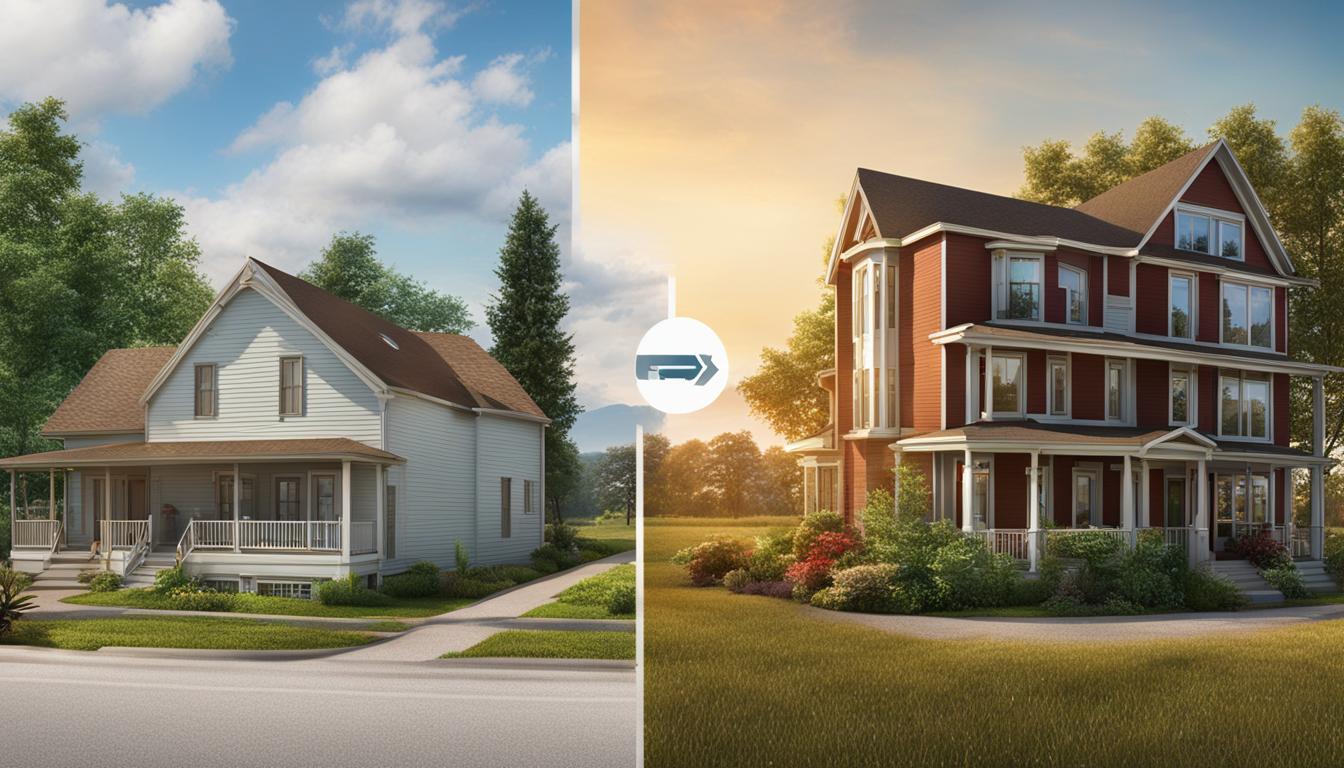Brad T.
March 24, 2024
When it comes to choosing a place to live, affordability is often a top consideration. Rural areas can offer a less expensive lifestyle compared to bustling cities, making them an attractive option for many individuals and families. In this article, we will explore why rural areas are typically more affordable than city life and the advantages of living in rural communities.
One of the main factors contributing to the affordability of rural areas is lower housing costs. Buying or renting a home in a rural area is often more budget-friendly compared to urban areas, where real estate prices can be significantly higher. This lower cost of living extends beyond housing and includes other essential expenses, such as groceries, utilities, transportation, and healthcare.
Living in a rural community also comes with its own unique benefits. The slower pace of life and closer connection to nature are appealing for those seeking a more relaxed and peaceful environment. Additionally, rural areas often have a stronger sense of community, with neighbors knowing and supporting one another.
In terms of education, rural areas can offer affordable options, including lower tuition fees and scholarship opportunities. Individuals living in rural communities may also have the opportunity to save on educational expenses by taking advantage of local resources.
Access to healthcare is another advantage of rural living. Medical care in rural areas is often more affordable, and individuals may find it easier to access healthcare facilities compared to congested urban areas. Lower health insurance premiums can also contribute to overall cost savings.
Employment and economic opportunities are available in rural areas as well. With the rise of remote work and the potential for entrepreneurship, individuals can enjoy a higher quality of life and good job prospects in industries such as agriculture, forestry, and tourism.
Transportation and commuting costs in rural areas are typically lower due to reduced fuel expenses, less congestion, and potentially shorter commute times. This adds to the overall affordability and convenience of living in a rural community.
It’s important to note that there are pros and cons to both rural and city living. While rural areas offer affordability and a closer connection to nature, urban areas provide access to a wider range of amenities and social opportunities. The decision ultimately depends on personal preferences and individual circumstances.
Key Takeaways:
- Rural areas are generally more affordable than city life due to lower housing and overall cost of living.
- Advantages of rural living include a slower pace of life, a stronger sense of community, and a closer connection to nature.
- Rural areas offer affordable education options, including lower tuition fees and scholarship opportunities.
- Rural communities often have easier access to healthcare facilities and lower health insurance premiums.
- Lower transportation and commuting costs contribute to the overall affordability of rural areas.
Lower Housing Costs in Rural Areas
When it comes to the cost of living, one of the most significant advantages of rural areas over urban environments is the lower housing costs. Buying or renting a home in a rural area is typically much more affordable than in a bustling city. This affordability not only provides financial benefits but also offers a range of potential lifestyle advantages.
In rural areas, the cost of housing is generally lower due to various factors. One reason is the lower demand compared to urban areas, resulting in lower prices. Additionally, rural areas often have more available land, allowing for larger properties at lower costs. The reduced population density and lower construction costs further contribute to the affordability of housing in rural areas.
The availability of affordable housing in rural areas presents individuals and families with an opportunity to enjoy a higher quality of life. With lower housing costs, individuals can allocate their financial resources more efficiently, allowing for greater financial stability and the ability to focus on other aspects of life, such as education, healthcare, and leisure activities.
Living in a rural area also offers a range of lifestyle benefits that can enhance overall well-being. Away from the hustle and bustle of the city, rural living provides a sense of tranquility and a closer connection to nature. Individuals can enjoy spacious yards, gardens, and the peace and quiet of a peaceful neighborhood. Moreover, rural areas often boast a strong sense of community, where neighbors support and look out for each other.
“Living in a rural area provides individuals with the opportunity to have a closer connection to nature and enjoy a slower pace of life. The sense of community is stronger, and the lower housing costs allow for greater financial freedom and stability.” – Jane Smith, Rural Living Enthusiast
By opting for rural living, individuals can enjoy the benefits of affordable housing, a simpler lifestyle, and a stronger community bond. The lower cost of housing in rural areas is just one of the many advantages that make rural living an attractive option for those seeking a more affordable and fulfilling way of life.
Cost of Living in Rural Neighborhoods
When considering the affordability of different living environments, it is essential to examine the overall cost of living in rural neighborhoods. Rural areas often provide a more economical lifestyle compared to urban areas, offering potential savings in various aspects of daily life.
Groceries and Goods
One significant advantage of living in a rural community is the usually lower cost of groceries and goods. With less demand and lower operating costs for retailers, items such as food, clothing, and household essentials tend to be more affordable in rural areas. This can positively impact monthly expenses and budget planning for residents.
Utilities and Housing
Rural living also often results in lower utility expenses. Utilities like electricity, water, and internet can be more cost-effective in rural neighborhoods due to lower demand and cheaper infrastructure maintenance. Additionally, the cost of housing, including rent or mortgage payments, is generally lower in rural areas than in urban centers. This offers potential savings and the ability to find spacious and comfortable homes at a more affordable price.
Transportation
In terms of transportation costs, rural areas may offer lower fuel expenses, reduced congestion, and shorter commute times. This can result in significant savings on transportation, as commuting costs and fuel consumption are typically lower compared to urban areas. Additionally, rural neighborhoods may provide opportunities for walking and biking, further reducing transportation expenses.
Healthcare Services
While healthcare costs can vary depending on various factors, including insurance coverage, rural areas may offer more affordable healthcare services. The cost of medical care, such as doctor visits and prescription medications, may be lower in rural communities. This can contribute to overall savings on healthcare expenses for individuals and families.
Comparison to Urban Areas
To highlight the potential savings associated with living in a rural neighborhood, let’s compare the cost of living in a rural community to that of an urban area. The table below provides a glimpse into the cost differences for various expenses:
| Expense | Rural Neighborhoods | Urban Areas |
|---|---|---|
| Groceries | Lower cost | Higher cost |
| Utilities | Lower cost | Higher cost |
| Housing | Lower cost | Higher cost |
| Transportation | Potential savings | Higher cost |
| Healthcare | Potential savings | Higher cost |
As depicted in the table, rural neighborhoods generally offer a more economical lifestyle across various expense categories, resulting in potential savings for individuals and families.
Living in a rural community can provide not only a lower cost of living but also a unique and rewarding lifestyle. It’s important to carefully consider the expenses associated with rural living and compare them to urban areas when determining the most affordable option for your specific circumstances.
Advantages of Rural Living
Living in a rural area offers numerous advantages that go beyond just affordability. Here are some of the benefits that come with embracing a rural lifestyle:
- Closer Connection to Nature: Rural areas are often surrounded by natural landscapes, providing residents with the opportunity to enjoy the great outdoors. Whether it’s going for a hike, exploring nearby forests, or simply enjoying the tranquility of nature, rural living allows for a closer connection to the environment.
- Slower Pace of Life: In contrast to the hustle and bustle of city living, rural areas offer a more relaxed and slower pace of life. Life in rural communities often revolves around a strong sense of community and taking the time to appreciate simple pleasures, which can contribute to a more balanced and less stressful lifestyle.
- Stronger Sense of Community: Rural areas are known for their tight-knit communities. Neighbors tend to know each other, and there is often a strong sense of camaraderie and support among residents. This fosters a sense of belonging and creates a support network that can be invaluable.
- Lower Crime Rates: Compared to urban areas, rural communities typically have lower crime rates. This provides residents with a greater sense of safety and security, allowing them to feel at ease in their surroundings and ensuring peace of mind for individuals and families.
“Living in a rural area offers a unique opportunity to reconnect with nature, embrace a slower pace of life, become part of a tight-knit community, and enjoy lower crime rates.” – [Author Name]
Embracing a rural lifestyle can provide individuals and families with a range of advantages that extend beyond just financial considerations. The ability to enjoy nature, live at a slower pace, benefit from a strong sense of community, and experience a safer environment are compelling reasons why many people choose rural living.
Next, we will explore the affordability of education in rural areas and the advantages it can offer.

Access to Affordable Education
In rural areas, individuals have access to affordable education opportunities that provide significant cost savings compared to city life. Lower tuition fees, scholarship opportunities, and reduced living expenses contribute to the overall affordability of education in rural communities.
Rural educational institutions often offer lower tuition fees compared to their urban counterparts. This financial advantage allows individuals to pursue higher education without accumulating excessive student loan debt. Students and their families can save a considerable amount of money by opting for affordable education in rural areas, making it an attractive option for those seeking quality education at a lower cost.
Furthermore, rural communities often have scholarship programs specifically designed to support local residents. These scholarships help alleviate the financial burden of education, making it more accessible and affordable. Students residing in rural areas may have a greater chance of receiving financial aid and scholarships that can further reduce their educational expenses.
Living in a rural community can also result in significant savings on educational expenses. Lower costs of living, including housing, utilities, and transportation, mean that individuals can allocate more of their budget to education. These financial savings can have a long-term impact, setting individuals up for financial success in the future.
“Education is the passport to the future, for tomorrow belongs to those who prepare for it today.” – Malcom X
The affordability of education in rural areas is not limited to primary and secondary schools. Colleges and universities located in rural regions often provide excellent educational opportunities that come with a more reasonable price tag. Students can enjoy a high-quality education without the burden of exorbitant tuition fees typically associated with urban universities.
| Educational Expenses | Rural Areas | Urban Areas |
|---|---|---|
| Tuition Fees | Lower fees due to rural lifestyle benefits and less competition | Higher fees due to increased costs of living and higher demand |
| Living Expenses | Lower cost of living, including housing, utilities, and transportation | Higher cost of living, including expensive housing and transportation options |
| Scholarship Opportunities | Local scholarship programs supporting rural residents | Competitive scholarship programs with more applicants |
In conclusion, rural areas offer individuals access to affordable education options, allowing them to pursue their academic goals without breaking the bank. With lower tuition fees, scholarship opportunities, and reduced living expenses, rural communities provide a financially viable alternative to city life for those seeking quality education.
Healthcare Availability and Affordability
When it comes to healthcare, rural areas have their own advantages over urban areas. Not only can individuals living in rural communities benefit from lower healthcare costs, but they also have easier access to healthcare facilities. This makes healthcare more affordable and attainable for residents of rural neighborhoods.
Rural areas offer lower medical care expenses compared to their urban counterparts. The cost of medical services, treatments, and prescription medications tends to be less expensive in rural communities. This can result in significant savings for individuals and families, allowing them to allocate their resources to other essential needs.
In addition to lower costs, rural areas often have a higher density of healthcare facilities per capita. The availability of hospitals, clinics, and healthcare practitioners is generally more accessible in rural neighborhoods. This is beneficial for residents who may require regular medical check-ups, emergency care, or specialized treatments.
| Healthcare Benefits in Rural Areas | Advantages |
|---|---|
| Easier access to healthcare facilities | Residents don’t have to travel long distances to receive medical care, reducing time and transportation expenses. |
| Potential savings on health insurance premiums | Insurance providers may offer lower premiums for rural residents due to the lower overall healthcare costs in these areas. |
| Inclusive community healthcare programs | Rural areas often have community-based healthcare initiatives that cater to the local population’s specific needs. |
It’s important to note that while rural areas offer affordability and accessibility in healthcare, certain specialized medical services may still require travel to urban centers. However, for routine care and general medical needs, rural areas provide an advantageous setting for individuals seeking affordable and accessible healthcare services.
Employment and Economic Opportunities
Living in rural areas not only offers a lower cost of living but also presents numerous employment and economic opportunities. The rise of remote work has offered individuals the chance to enjoy the advantages of rural living while pursuing fulfilling careers. With the use of technology, professionals can now work from the comfort of their homes in peaceful rural settings, avoiding the hustle and bustle of busy urban centers.
Rural areas also provide an environment conducive to entrepreneurship. The affordability of rural living allows individuals to invest their savings in starting their own businesses. Whether it’s opening a small farm, starting a bed and breakfast, or creating unique handmade crafts, rural areas offer a fertile ground for entrepreneurial endeavors.
The job prospects in certain industries are particularly promising in rural areas. Agriculture, forestry, and tourism are just a few examples of sectors that thrive in rural communities. Farmers can take advantage of the fertile land, providing a sustainable source of income while contributing to local food production. Forestry offers opportunities for both employment and conservation efforts, ensuring the preservation of natural resources. Tourism draws visitors to rural destinations, creating a demand for services such as accommodation, dining, and recreational activities.
While urban areas certainly offer their own set of job opportunities, rural living provides a unique chance for individuals to pursue fulfilling careers while enjoying a higher quality of life. With the combination of remote work, entrepreneurial possibilities, and thriving industries, rural areas offer a wealth of employment and economic opportunities.
Image:

| Advantages of Employment and Economic Opportunities in Rural Areas |
|---|
| 1. More affordable cost of living |
| 2. Flexibility of remote work |
| 3. Opportunities for entrepreneurship |
| 4. Promising job prospects in agriculture, forestry, and tourism industries |
Transportation and Commuting Costs
When considering the cost of living in rural areas versus urban environments, transportation and commuting expenses play a significant role. Rural living offers several advantages that contribute to overall affordability, including lower fuel expenses, reduced congestion, and potentially shorter commute times.
In rural areas, the daily commute is often less demanding and more efficient compared to the traffic-laden roads of the city. With fewer vehicles on the road, commuting times tend to be shorter, allowing residents to spend less time traveling and more time enjoying the benefits of rural living.
Fuel Expenses
One of the most apparent advantages of living in a rural area is the lower fuel expenses. In cities, individuals may need to commute longer distances due to the higher population density and the need to travel between various urban areas. This leads to increased fuel consumption and consequently, higher expenses.
In contrast, rural areas generally have shorter commuting distances, with essential amenities and services often located in close proximity to residential areas. This proximity translates to reduced fuel consumption and lower overall transportation costs, contributing to a more affordable cost of living.
Reduced Congestion
Compared to urban areas, rural regions experience significantly less traffic congestion. The absence of heavy vehicular traffic and crowded roadways not only reduces commuting times but also minimizes wear and tear on vehicles, leading to potential savings in maintenance and repair costs.
Moreover, the reduced stress associated with commuting in a calm and less congested environment can have a positive impact on the overall well-being of individuals living in rural areas.
Shorter Commute Times
Rural living often offers the advantage of shorter commute times, as residential areas are typically located in closer proximity to workplaces, schools, and other essential facilities. This proximity allows individuals to spend less time commuting and more time engaging in activities they enjoy or spending quality time with family and friends.
The time saved on commuting can have a significant impact on an individual’s work-life balance, contributing to a higher quality of life and a sense of satisfaction in rural living.
| Rural Living | Urban Living |
|---|---|
| Lower fuel expenses | Higher fuel expenses |
| Reduced congestion | Heavy traffic congestion |
| Shorter commute times | Longer commute times |
By comparing transportation and commuting costs in rural and urban areas, it becomes evident that the advantages of rural living extend beyond affordability. The convenience of shorter commutes, reduced congestion, and lower fuel expenses enhance the overall quality of life for individuals residing in rural communities.
Pros and Cons of Rural vs. City Living
When deciding between rural and city living, it’s essential to consider the advantages and disadvantages of each lifestyle. While rural living offers a tranquil and close-to-nature environment, city life provides a bustling urban experience with numerous amenities. Let’s explore the pros and cons of rural and city living to help you make an informed decision.
Advantages of Rural Living:
- Serenity and Natural Beauty: Rural areas offer a peaceful and scenic environment, surrounded by breathtaking landscapes and fresh air. Living close to nature can have a calming and rejuvenating effect on your well-being.
- Tight-Knit Communities: Rural communities often have a strong sense of belonging and foster close relationships among their residents. If you value a tight-knit and supportive community, rural living may be ideal for you.
- Lower Cost of Housing: One of the major advantages of rural living is the affordability of housing. Compared to the rising urban housing prices, rural areas provide more affordable options for homeownership or rental.
- Less Crime: Rural areas generally have lower crime rates than urban areas, providing a safer living environment for you and your family.
- Opportunities for Self-Sufficiency: Rural living allows you to engage in activities such as gardening, farming, and livestock rearing, fostering self-sufficiency and a deeper connection to the land.
Disadvantages of Rural Living:
- Limited Amenities: Rural areas may have limited access to amenities such as shopping centers, entertainment venues, or specialized healthcare facilities. You might need to travel further for certain services or goods.
- Less Job Opportunities: Finding diverse job opportunities in rural areas can be challenging, with limited options compared to the vibrant job markets in cities. Remote work and entrepreneurship might be viable alternatives.
- Transportation Challenges: Rural living often involves longer commutes, limited public transportation options, and higher costs for fuel and vehicle maintenance.
- Isolation and Social Opportunities: While rural living provides a close community, it may lack the social and cultural opportunities that cities offer. Access to a variety of events, art exhibitions, and diverse social groups might be limited.
Advantages of City Living:
- Abundance of Amenities: Cities offer a wide range of amenities, including shopping malls, restaurants, cultural activities, and entertainment options. Everything you need is typically within close proximity.
- Diverse Job Opportunities: Urban areas are known for their diverse job market and numerous career opportunities. Industries such as finance, technology, and creative fields often thrive in cities.
- Public Transportation: Cities usually have well-developed public transportation systems, making commuting easier and reducing the need for car ownership. This can save you money and contribute to a greener lifestyle.
- Social and Cultural Experiences: City life provides a vibrant and diverse social scene, with access to art galleries, museums, theaters, music venues, and multicultural events. You can immerse yourself in a variety of cultural experiences.
Disadvantages of City Living:
- High Cost of Housing: Urban areas often come with high housing costs due to high demand and limited space. Owning or renting a property in the city can be considerably more expensive than in rural areas.
- Noise and Pollution: Cities are bustling with activity, which means more noise and air pollution. If you prefer a quieter and cleaner environment, city living might not be the best fit.
- Increased Stress: The fast-paced nature of city life can be stressful for some individuals. Crowded streets, traffic congestion, and the constant hustle and bustle can take a toll on your mental well-being.
Ultimately, the decision between rural and city living depends on your personal preferences, priorities, and individual circumstances. Consider the pros and cons outlined here, and choose the lifestyle that aligns with your values and goals.
“The choice between rural and city living should be based on your own needs, preferences, and the lifestyle that will bring you the most happiness and fulfillment.”
Environmental Considerations
Living in rural areas not only offers financial advantages but also brings several environmental considerations that can enhance the quality of life. Here are some key reasons why rural living promotes a healthier and more sustainable environment:
- Reduced Pollution: Rural areas generally have lower levels of pollution compared to densely populated cities. With fewer vehicles and industrial activities, the air quality in rural communities is often better, leading to improved respiratory health and well-being.
- Opportunities for Sustainable Practices: Rural living provides ample opportunities for individuals to adopt sustainable practices. With more land available, people can grow their own food through gardening or farming, reducing reliance on industrial agriculture and minimizing the carbon footprint associated with long-distance food transportation.
- A Healthier Lifestyle Connected to Nature: Rural areas offer a closer connection to nature, allowing residents to enjoy outdoor activities, such as hiking, fishing, and gardening. Access to green spaces and natural environments has been linked to numerous health benefits, including reduced stress levels, improved mental well-being, and increased physical activity.
By embracing rural living, individuals can contribute to the preservation of the environment, promote sustainable practices, and enjoy a healthier lifestyle in harmony with nature.
Example Sustainable Practices in Rural Areas
| Sustainable Practice | Description |
|---|---|
| Renewable Energy | Rural areas are ideal for harnessing renewable energy sources such as solar, wind, and hydro power. Many rural communities have embraced clean energy initiatives, contributing to reduced reliance on fossil fuels and a greener environment. |
| Water Conservation | Rural living often involves conscious water use. Practices such as rainwater harvesting, efficient irrigation systems, and responsible water management help preserve this valuable resource and protect local ecosystems. |
| Waste Reduction and Recycling | Living in rural areas encourages individuals to adopt waste reduction and recycling practices. Composting, reusing materials, and participating in community recycling programs contribute to minimizing waste generation and promoting a circular economy. |
“Living in a rural area allows us to reconnect with the natural world and adopt a more sustainable lifestyle, benefiting both ourselves and the environment.” – Jane Thompson, Sustainable Living Advocate
Conclusion
After examining the various aspects of rural living versus city life, it is clear that rural areas offer numerous advantages, particularly in terms of affordability. Rural areas are typically more affordable than city life, offering lower housing costs, a lower overall cost of living, and access to affordable education and healthcare.
In addition to the financial benefits, living in a rural area also provides a closer connection to nature, a slower pace of life, a stronger sense of community, and lower crime rates. These factors contribute to a higher quality of life and a more fulfilling lifestyle. While there are certainly pros and cons to consider when choosing between rural and city living, the affordability and unique benefits of rural areas make them a compelling option for many individuals and families.
Choosing to live in a rural area can provide significant cost savings, allowing individuals to stretch their budget further and potentially achieve a higher standard of living. Whether it’s enjoying the tranquility of rural landscapes, participating in close-knit communities, or benefiting from a more sustainable and environmentally-friendly lifestyle, rural living offers a wealth of advantages that should not be overlooked.
FAQ
Why are rural areas typically more affordable than city life?
What are the advantages of living in rural areas?
How does the cost of housing in rural areas compare to urban areas?
What factors contribute to the lower cost of living in rural neighborhoods?
Are education expenses generally lower in rural areas?
How does healthcare availability and affordability differ in rural areas?
What employment and economic opportunities are available in rural areas?
Are transportation and commuting costs generally lower in rural areas?
What are the pros and cons of rural living compared to city life?
What environmental considerations should be taken into account when choosing rural living?
Recent Blogs
The Joys of Living In Rural Areas: Serene Bliss
Living in rural areas offers a unique and enchanting experience that is unparalleled. The serene bliss of countryside living provides a break from the hustle and bustle
Land Investment: Value Increase Over Time Explained
Welcome to our guide on investing in land and understanding the potential value increase over time. Land can be a lucrative investment opportunity, offering enticing returns and
Benefits of Home Gardening: Why It’s Vital
Welcome to our article on the benefits of home gardening. In today's fast-paced world, where convenience often takes precedence, the act of nurturing and growing plants in
Living in the Appalachians: Insights & Lifestyle
Welcome to the breathtaking region of the Appalachians, where the beauty of the mountains and the warmth of its communities create a unique and enriching living experience.
Why More Americans Choose Rural Life in 2024
Over the past decade, there has been a noticeable trend of Americans moving away from crowded cities and embracing the quiet, serene lifestyle of rural areas. In
Investing in Rural Land: Essential Tips
Are you considering investing in rural land? Whether you're looking for a peaceful getaway or an opportunity to diversify your investment portfolio, rural land can offer unique
Comparing Affordability: Rural Living vs. City Living
When it comes to choosing a place to live, affordability is often a top consideration. Rural areas can offer a less expensive lifestyle compared to bustling cities,
The Importance of Prepping and Survival Skills – Interviewing David
The Importance of Prepping and Survival Skills: Interviewing David Savage Ever wonder what you'd do in a crisis situation in which
How to Know if a Property is in a Flood Zone
How to Know if a Property Is in a Flood Zone Here, we'll share a really quick way that will allow you to know










